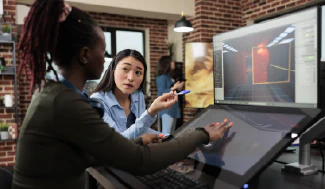Emergency Communication Without Smartphones for K-12 Schools

Effective emergency communication in K-12 schools is vital for maintaining safety and ensuring swift incident response. However, many schools are implementing strict policies that limit smartphone usage to create distraction-free learning environments, combat bullying, and prevent cheating. While these policies are beneficial for education, they pose challenges during emergencies when cell phones may not be accessible. Additionally, many teachers do not keep their cell phones near when instructing classes and weather events or infrastructure issues can disrupt cellular networks, making it essential for schools to consider multi-channel communication options even when cell phones are permitted.
To address these challenges, schools must explore alternative solutions that facilitate effective incident management. This blog examines various options, ensuring schools can handle emergencies without relying on smartphones.
Non-Smartphone Solutions for Emergency Communication
To ensure effective communication during emergencies without relying on smartphones, schools can implement a range of alternative tools and strategies designed for reliability and accessibility.
Panic Buttons
One of the most effective solutions for overcoming the inability to call for help from a cell phone is the use of panic buttons. These devices provide an immediate and direct connection to security teams or emergency responders. Panic buttons come in various forms, including keyboard models, wearable designs and wallmounted options. They can be activated with a simple keystroke or button press, quickly sending precise alerts and location details to the appropriate security personnel, expediting response times and mitigating potential harm or damage.
Many of these devices offer additional benefits, such as incident-type selection features to ensure the appropriate safety teams respond. Additionally, panic buttons may have video and audio streaming capabilities, which allow responders to assess the situation before arriving on the scene, further enhancing the effectiveness of their response. Some devices feature two-way communication capabilities, which allow users to speak with security while waiting for in-person support. Post-activation location tracking is another critical feature that ensures emergency responders can reach individuals even if the nature of the incident requires them to move.
The features available on panic button devices vary depending on the solution and vendor you choose. Consider which features are most valuable for your organization’s needs before implementing a panic button system.
Two-Way Communication Devices
For direct, real-time communication among staff members, two-way radios (walkie-talkies) are an invaluable resource. These devices are particularly effective in large school buildings where cellular networks might be weak, ensuring immediate and reliable communication to coordinate responses during critical incidents.
Although less common today, landlines and public phones remain reliable tools for emergency communication. They provide direct access to key personnel or emergency services and are unaffected by cellular network disruptions, making them a vital backup option.
Auditory Alerts
Emergency signal bells offer another communication layer, using distinct sounds to trigger specific pre-defined actions. For instance, one bell sound could indicate a lockdown, while another signals an evacuation, allowing for quick recognition and response to different emergencies.
Another essential tool is the school intercom system, which allows mass communication by broadcasting emergency messages to all classrooms and common areas. These systems ensure that everyone on campus receives clear and timely instructions, helping to maintain order and reduce confusion during high-stress situations.
Visual Alerts
Visual alerts, such as screen takeovers, can further enhance emergency communication. Emergency notification systems can push notifications to mounted TVs and computers throughout the building, providing critical information at a glance and reinforcing verbal instructions with visual cues.
Making Emergency Communication Tools Effective
To maximize the effectiveness of emergency communication tools, schools must invest in training and establish clear communication protocols. Conduct regular drills to familiarize staff and students with all available emergency communication methods. Furthermore, establish designated communication channels to clarify who is responsible for initiating and relaying emergency messages.
Accessibility is also crucial. Schools need to offer a variety of communication tools that accommodate individuals with disabilities, including those with visual or auditory impairments. These accommodations ensure the entire school community remains safe and informed during an emergency.
Conclusion
Smartphones may dominate modern communication, but they are not always available or reliable in K-12 schools. Schools can maintain effective emergency communication and critical incident command even without smartphones by adopting and training with alternative tools like panic buttons, two-way radios, intercom systems and more.
At 911Cellular, we specialize in providing NIST-tested, WiFi-compatible solutions designed to enhance safety and streamline emergency response. Our tools, from panic buttons to integrated communication systems, help schools reduce response times and save lives. Learn how we can help your school ensure peace of mind with a full-service security solution: 911cellular.com/industries/k12schools/.



